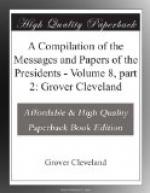The single substantive matter charged is the attempt to prevent the execution of the tenure-of-office act, and the other facts are alleged either as introductory and exhibiting this general purpose or as showing the means contrived in furtherance of that attempt.
This single matter, connected with the other matters previously and subsequently alleged, is charged as the high misdemeanor of which the President is alleged to have been guilty.
The general question, guilty or not guilty of a high misdemeanor as charged, seems fully to cover the whole charge, and will be put as to this article as well as to the others, unless the Senate direct some mode of division.
In the tenth article the division suggested by the Senator from New York (Mr. Conkling) may be more easily made. It contains a general allegation to the effect that on the 18th of August and on other days the President, with intent to set aside the rightful authority of Congress and bring it into contempt, delivered certain scandalous harangues, and therein uttered loud threats and bitter menaces against Congress and the laws of the United States enacted by Congress, thereby bringing the office of President into disgrace, to the great scandal of all good citizens, and sets forth in three distinct specifications the harangues, threats, and menaces complained of.
In respect to this article, if the Senate sees fit so to direct, the question of guilty or not guilty of the facts charged may be taken in respect to the several specifications, and then the question of guilty or not guilty of a high misdemeanor, as charged in the article, can also be taken.
The Chief Justice, however, sees no objection to putting the general question on this article in the same manner as on the others; for, whether particular questions be put on the specifications or not, the answer to the final question must be determined by the judgment of the Senate whether or not the facts alleged in the specifications have been sufficiently proved, and whether, if sufficiently proved, they amount to a high misdemeanor within the meaning of the Constitution.
On the whole, therefore, the Chief Justice thinks that the better practice will be to put the general question on each article without attempting to make any subdivision, and will pursue this course if no objection is made. He will, however, be pleased to conform to such directions as the Senate may see fit to give in this respect.
Whereupon it was
Ordered, That the question be put
as proposed by the Presiding
Officer of the Senate, and each Senator
shall rise in his place and
answer “guilty” or “not
guilty” only.
SATURDAY, MAY 16, 1868.
THE UNITED STATES vs. ANDREW JOHNSON, PRESIDENT.
The Chief Justice stated that, in pursuance of the order of the Senate, he would first proceed to take the judgment of the Senate on the eleventh article. The roll of the Senate was called, with the following result:




